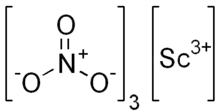Scandium nitrate
Scandium(III) nitrate, Sc(NO3)3, is an ionic compound. It is an oxidizer, as all nitrates are. The salt is applied in optical coatings, catalysts, electronic ceramics and the laser industry.
 | |
| Names | |
|---|---|
| IUPAC name
scandium(3+) trinitrate | |
| Identifiers | |
3D model (JSmol) |
|
| ECHA InfoCard | 100.033.350 |
| EC Number |
|
PubChem CID |
|
| UNII | |
CompTox Dashboard (EPA) |
|
| |
| |
| Properties | |
| Sc(NO3)3 | |
| Molar mass | 230.97 g/mol |
| Appearance | off-white crystals |
| Solubility in other solvents | water and strong mineral acids |
| Related compounds | |
Related compounds |
Scandium(III) chloride Scandium(III) fluoride |
Except where otherwise noted, data are given for materials in their standard state (at 25 °C [77 °F], 100 kPa).
Infobox references | |
Preparation
Scandium nitrate can be prepared by the reaction between scandium metal with dinitrogen tetroxide.[1]
- Sc + 3 N2O4 → Sc(NO3)3 + 3 NO
The anhydrous form can also be obtained by the reaction between scandium chloride and dinitrogen pentoxide.[2] The tetrahydrate can be obtained from the reaction between scandium hydroxide and nitric acid.[3]
Properties
Scandium nitrate is a white solid which dissolves in water and ethanol.[4] It has multiple hydrated forms, including the dihydrate, trihydrate, and tetrahydrate. The tri- and tetrahydrate exist in the monoclinic crystal system. Upon heating in air to 50 °C, the tetrahydrate transforms into the dihydrate, which at 60 °C further converts to Sc4O3(NO3)3·6.5H2O. At 140–220 °C, Sc4O5(NO3)3 is formed.[2]
Scandium nitrate has been found to form clusters when in an aqueous solution which can affect its behavior and properties in various ways. Small Angle neutron scattering[5] has been used in experiments to show the clusters can contain as many as 10 scandium ions. This number depends on the concentration of the original scandium nitrate in the solution.
Scandium nitrate,[6] also known as Sc(NO3)3, is a white crystalline powder or solid with a molecular weight of 276.996 g/mol. This compound has a melting point of 180 degrees Celsius and a density of 2.80 g/cm3. It is soluble in water and polar organic solvents like methanol or ethanol, but insoluble in nonpolar solvents such as benzene and toluene. Scandium nitrate decomposes before it can boil, and therefore has no boiling point.
However, it is essential to handle this compound with care, as it can cause harm if swallowed, inhaled, or absorbed through the skin barrier. Exposure to scandium nitrate can cause skin, eye, and respiratory discomfort and irritation, and repeated exposure or extended exposure to this compound can lead to organ damage. Therefore, proper precautions should be taken when handling scandium nitrate to avoid any potential harm to health or the environment.
Applications
Scandium nitrate has been found to be a successful catalyst in chemical reactions such as Beckmann rearrangement of ketoximes to amides[7] and the isomerization of allylic alcohols to aldehydes. The catalytic success of scandium nitrate can be increased by modifying its structure in ways such as adding a co catalyst. Scandium nitrate is also the precursor for the synthesis of other scandium based compounds such as scandium oxide or scandium hydroxide. Scandium nitrate has also been investigated for its potential in luminescent materials due to its ability to strongly emit in the blue region of the spectrum.
References
- Brauer, Georg (1975). Handbuch der präparativen anorganischen Chemie (3rd ed.). Stuttgart: Enke. p. 1109. ISBN 3-432-02328-6. OCLC 310719485.
- Scandium : its occurrence, chemistry, physics, metallurgy, biology, and technology. Chaim T. Horovitz. Academic Press. 2012. p. 119. ISBN 978-0323144513. OCLC 768016723.
{{cite book}}: CS1 maint: others (link) - Riedel, Erwin (2011). Anorganische Chemie. Christoph Janiak (8th ed.). Berlin: De Gruyter. p. 773. ISBN 978-3-11-022567-9. OCLC 753966312.
- William M., Haynes (2012). CRC Handbook of Chemistry and Physics. William M. Haynes (93rd ed.). Boca Raton, FL: CRC. p. 86. ISBN 978-1-4398-8049-4. OCLC 793213751.
- Karavaev, I. A.; Savinkina, E. V.; Grigor’ev, M. S.; Buzanov, G. A.; Kozerozhets, I. V. (2022-08-01). "New Coordination Compounds of Scandium Nitrate with Carbamide: Precursors for the Preparation of Nanosized Scandium Oxide". Russian Journal of Inorganic Chemistry. 67 (8): 1178–1183. doi:10.1134/S0036023622080186. ISSN 1531-8613. S2CID 252204399.
- PubChem. "Scandium nitrate". pubchem.ncbi.nlm.nih.gov. Retrieved 2023-04-25.
- Sekine, Tatsuya; Hasegawa, Yuko (February 1966). "Studies of Scandium in Various Solutions. I. An Ion-Exchange Study of Scandium(III) Chloride and Nitrate Complexes". Bulletin of the Chemical Society of Japan. 39 (2): 240–243. doi:10.1246/bcsj.39.240. ISSN 0009-2673.